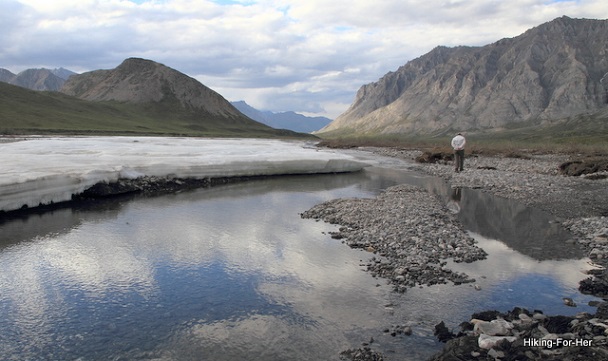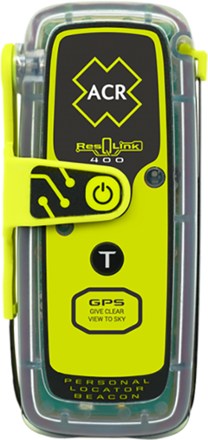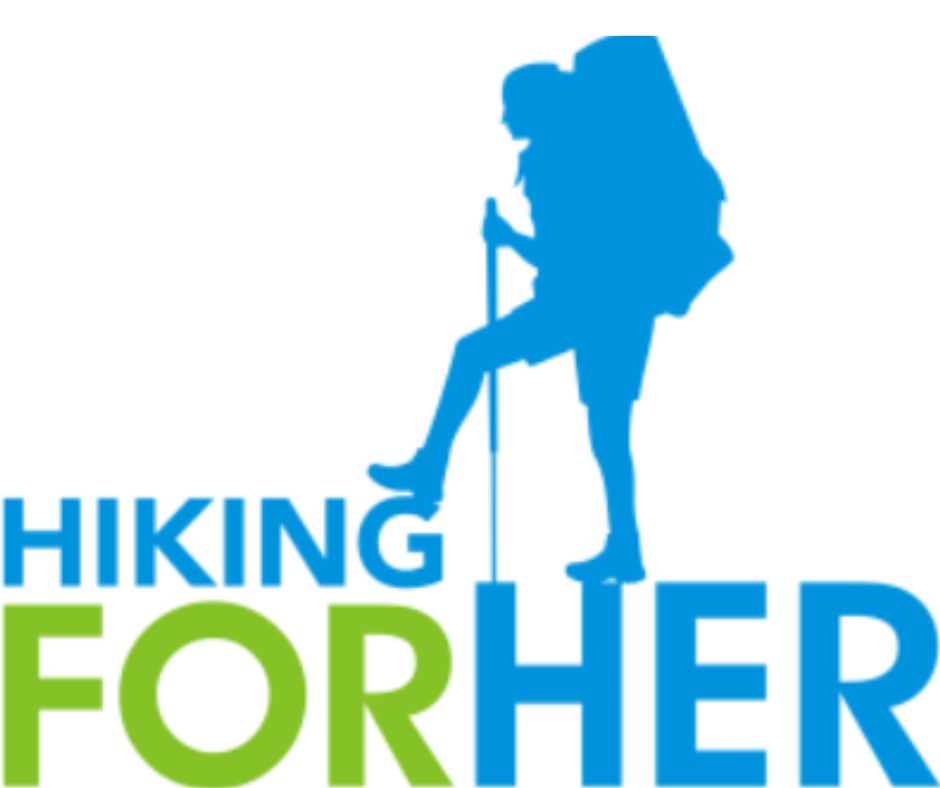Best Personal Locator
Beacons For Your Hiking Safety
By Diane Spicer
Personal locator beacons do pretty much what they promise:
- Locate your person, and then report your position to someone who will perform a "search and rescue" to find you.
The best PLBs are small, portable, reliable and weather proof hiker emergency beacons.
But there's one thing you need to know right away:
There is no two-way communication available with beacons, only the transmission of an SOS message.
- SOS is the the International Morse code distress signal, reserved for use only in a true emergency.
If you're interested in two-way communication devices, read about satellite messengers instead.
So why would you want to carry a seemingly limited personal locator beacon (PLB) on your hikes?
Great question!
Personal locator beacons (PBLs):
let's begin with a caveat
A PLB is designed for one thing: to send an emergency message.
If you're a solo hiker and you suffer an injury or are lost, one push of a button will summon help.
Or you and a trail buddy get turned around, night falls, and you're unprepared for it.
If self rescue is impossible, don't hesitate to use this electronic device!
But here's the kicker: you should be in a dire emergency situation to consider activating your emergency beacon.
- A broken trekking pole doesn't count.
- Spotting a bear two ridges over doesn't count.
- Medical emergency such as broken bones, bleeding or loss of consciousness, now you're talking about when to send an SOS message.
Careful use is really important
It's important to understand the distinction between a non-emergency and a "quick, hit the button" situation, because once you hit the "HELP" button, your message goes via satellites to some pretty high powered folks:
- National Oceanic and Atmospheric Administration: NOAA (US)
- U.S. Air Force Rescue Coordination Center: AFRCC
- Search and Rescue Satellite Aided Tracking, an international cooperation of military satellites: COSPAS-SARSAT
They won't be pleased to rescue someone with a broken trekking pole, if you take my meaning.
And the cost of your rescue gets billed to YOU.
So if you plan on carrying a personal locator beacon, be very sure you need to deploy it before sending that emergency message.
Because these
babies work, and work very well, to send an SOS message that will get you
rescued ASAP (having fun with the acronyms yet?).
Personal locator beacons:
a few more caveats
To make your learning curve short and simple for how to use a PLB properly for an emergency rescue:
- You must register your PLB device with NOAA, using a unique identifying number which will be used when locating you. Registration is free, but if you forget to do it, your device is useless in an emergency situation.
- These devices use satellites, so you must be in a position where the device and the satellites "see" each other. Deep canyons, thick forests, sometimes even dense clouds (or blocking the signal with your pack or clothing) will obscure the signalling.
- If your signal is transmitted at night, you will have to wait for daylight for a helicopter or land based rescue team to arrive.
- The accuracy of your locator signal depends on which type of PBL you buy. If your device uses GPS, you'll be assured of rescuers pinpointing you to within 100 meters in 5 minutes or less.
- Without a GPS interface, accuracy drops to 2 miles before switching to a different frequency to pinpoint you more exactly. Why does this matter? Time. If you're bleeding or losing consciousness, time is of the essence.
- This is a battery-dependent device, so it's only as reliable as your commitment to doing regular battery checks/replacement. Also, cold temperatures will eat into the battery life.
- You must flip the "on" switch to activate the signal transmission. Be conscious of the battery life and guard against it getting flipped accidentally.
- Some of these devices are pre-programmed; be sure it's going to work if you're headed outside of the country in which you purchased the device.
Do you need to carry a
personal locator beacon?
 ANWR solitude in Alaska, USA
ANWR solitude in Alaska, USAOnly you can answer this question, by calculating your personal risk/benefit ratio.
There are types of hiking which skew this ratio toward probably wanting to carry the best personal locator beacon available.
Let's take a look so you can identify your needs.
Solo hikers
This is one of the very best reasons for carrying a PLB: solo hiking.
When you hike alone frequently (your canine companion doesn't count in this discussion due to lack of opposable thumbs), or venture off established trails into the backcountry, consider the merits of these lightweight portable personal locator beacons.
While you are probably very committed to safety and advance planning of routes, you can't control sudden weather events or trail closures.
You can't predict wildlife encounters.
And you have no control over accidents or injuries that can happen to any of us on a trail, especially when you're way off the beaten path.
For these reasons, I'd recommend you carry a PLB in your backpack.
And don't forget, you have to activate the device when you need it.
- Don't bury it in your backpack where it may be inaccessible if you're injured or your pack is swept away in a water crossing accident.
- Be extra diligent about battery life, if this is your only way to summon help.
I also like to be Captain Obvious, so I will say that practice at home makes perfect when push comes to shove on the trail.
Personal locator beacons
for backcountry hikers
If you risk going into the backcountry on a regular basis, perhaps it's time to take a look at purchasing one of these devices.
Even in a group hiking situation, things can go south on you and you'll need to be rescued.
Let's define backcountry first:
- isolated, rarely traveled regions
- rugged terrain with dicey footing, water crossings, high probability of predator encounters
- extreme and/or unpredictable weather conditions
Here are a few of my favorite backcountry adventures, to give you a better idea of what's at stake.
Personal example
I've been on multiple backcountry Alaska and Canada trips where I had great peace of mind, knowing we had a PLB with us.
- It's just an extra little edge for making risk-taking more comfortable.
Some folks I've hiked with grouse about paying for something you never use.
But that's exactly the point: buy it, activate it, carry it, maintain it, and be very thankful you never use it!
It's a personal calculus
Calculate for yourself the worth of what you are purchasing:
- Lightweight peace of mind
- Free registration
- Assurance of rescue wherever you wander (although there are constraints such as daylight, weather conditions, and mileage - those darn laws of physics)
But also keep in mind these factors
- You bear the full cost of the rescue (helicopters aren't cheap!).
- A PLB is not a trivial piece of hiking gear to purchase; average cost hovers around $300.
- Battery maintenance is your responsibility.
- Emergencies only: you must define EMERGENCY as life threatening issues only.
- If you need advice or non-emergency assistance, use your satellite messenger instead.
- There is no two-way transmission; only a "HELP" message will be sent (and may not be sent and/or received, depending on where you are).
- Once the message is sent, the genie is out of the bottle, so to speak. You can't take it back!
- Depending on where you are, rescue can take many hours, even days, if the weather and terrain conspire against the rescuers.
Here's what REI Co-op has to say about choosing between a personal locator beacon and a satellite messenger.
A few PLB tips for hikers
Because you might not be familiar with a personal locator beacon and the ramifications it may have on your life, here are a few pointers for distinct types of hiking.
Backcountry adventurers
If you can purchase trip insurance for your hiking trip, do so.
- If you are being guided by a registered guide or company, you can get insurance to cover an emergency.
- Buy a policy that covers the cost of helicopter evacuation, medical treatment, and other out of pocket expenses if you hit the SOS button and are rescued.
- Usually the policy runs ~10% of the total cost of the trip, and must be purchased within a few weeks of booking the trip to give you the best chance of good coverage.
If you hike on your own in remote locations, insurance won't be an option.
All costs of a rescue operation will come out of your pocket. But in an emergency, don't let that stop you from hitting the go button!
Day hikers
If you're a casual day hiker and you stick to well marked, established trails, you probably don't need a device of this technological sophistication.
- It's an added expense in your hiking budget.
- And added weight in your backpack.
However, if you're hiking with kids who love to venture off trail, leap off rocks, jump into streams and run ahead of you on the trail, maybe a PLB is a good idea for your peace of mind.
Do a quick calculation on the probability of needing one, using these questions:
- How far from the trailhead is your typical day hike?
- How busy are the trails you use?
- Do you have the strength to carry a child to safety?
- How active and adventuresome are you and your kids?
- Are you prepared to get everyone safely through a long, cold night?
If you're within a few miles of a trailhead, and pass a lot of folks on your way up and back down the trail, you can rely upon the good graces of other hikers to help you in an emergency.
And if your luck is running high, maybe one of them will have a PLB in an emergency situation.
Tips for maximizing the best
personal locator beacons
If you activate your PLB, do everything you can to make yourself highly visible to the rescuers.
Some PLBs have LED strobe lights to assist with this very smart move.
If you carry a reflective space blanket, a whistle, an old CD or DVD you can flash, use them to attract attention once you hear the helicopter or see rescuers approaching your area.
And here's the clincher:
Get out from under trees, ravines or rocky overhangs, into as much open space with a view of the sky as possible, before you activate your PLB.
- Give the signal the best chance of quickly finding its target satellites.
Recommended PLBs
Alright, time to do some thinking about the best way to transmit a one-way SOS message for immediate rescue.
This PLB weighs less than 5 ounces, has a small compact footprint in your pack, and provides a GPS enabled rescue beacon.
Trail Tip:
This may sound like harping, but please!
Once you buy a PLB, register it immediately and then add "battery checks" to your hiking calendar and gear lists.
A dead PLB is a useless PLB, extra weight for nothing.
Here's another option from ACR Electronics
If you wander all over the map, this beacon can relay your location without needing a subscription service.
 ACR Electronics ResQLink 400 Personal Locator Beacon | REI Co-op ACR Electronics ResQLink 400 Personal Locator Beacon | REI Co-op
|
You can self-test the system so you know it's working reliably before and during your trip. Great habit to get into: a regular technology check. |
If a PLB doesn't sound right for you, maybe you need a SEND device (Satellite Emergency Notification Device) instead.
- Read about them here.
Home page > Best Hiking Gear >
Personal Locator Beacons
|
I get emails all the time about what I wear, eat, carry and love to use on the trail. That's
why I provide affiliate links to you: the best gear that I use myself and have seen used by other hikers is instantly
available for your consideration, and the gear company sends a few
pennies per dollar to this reader-supported hiking website. There is no added cost to you! Everyone ends up a winner: Great gear for you, strong gear companies, and more free hiking tips for everyone. Thanks very much for your support. It's warmly and sincerely appreciated. It also helps send these hiking tips to all your virtual trail buddies around the globe. |
 |


